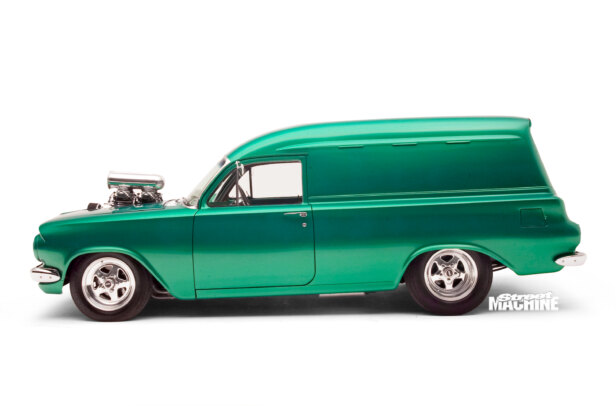BACK in 1971, the panel van was regarded as little more than a delivery platform for small business and a convenient mobile home for surfers. Hot rods, customs and drag racing were the big things on the car scene back then, but change was coming. Three young guys from Sydney’s northern beaches saw the panel van’s potential as both a mobile art gallery and a high-performance vehicle, helping launch a craze that dominated the Aussie hot car scene for a decade.
First published in the February 2021 issue of Street Machine. Photos: Dave Cook & SM Archives
The three guys – Patrick Soars, Ed Covey and Chris Yock – were all members of the Manly Rod & Custom Club. Pat is the subject of our story, and while he went on to great success in the business world, he still loves panel vans.
Ed Covey’s Anteater, Pat’s Green Ant and Chris Yock’s Samurai line up on Collaroy Beach for their Street & Strip shoot in 1972. Anteater was the quickest, with a 14.2 to its name, while Samurai had the wildest interior, featuring pop-art paintings by Paul Norman
Patrick is the founder and managing director of Australian Native Landscapes, a gardening, agriculture and environmental organic waste and recycling behemoth, the largest organics recycler in Australia. Today it retains over 300 employees and runs over 200 trucks, but in 1971 the company consisted of Pat and one humble Holden panel van – into which he threw bags of cement, tools, rocks and loads of wood chips to deliver the basics of a nice front garden to a small pool of clients.
With a jacked rear, chrome diff and big rubber, Ed Covey’s Anteater was a trendsetter. Warren Amiott did the paint, while Clinton Signs handled the rest
“I was paddock-bashing cars from about 12 or 14 and loved anything mechanical; still do,” says Patrick. “But I also had an affinity for gardening and landscaping, so I was lucky that I could combine the two throughout my career. Having that understanding of things mechanical and how they work – and a passion for Holden – has really helped me in my business career.
“Because of my mechanical interests, I had no fear of pioneering the processing of many different forest materials – like bark and sawdust and others – and shipping them around in bulk. It made ANL what it is today.”
There was a time when being a custom car fan could blend the pastimes of surfing, hot rodding, drag racing and the show scene. Here The Green Ant sits on display at the 1972 NSW Hot Rod Show
Patrick bought the 1963-model van second-hand when it was three years old. He chose the panel van because he recalled early Holden advertising from 1963 and ’64, when he was 13 or 14. “The ad was on the roadside near Newcastle, and I just loved the shape and I wanted to be different,” he says.
“Within 24 hours of buying it, I had a different muffler on it; the following weekend I changed the manifold and fitted twin Strombergs,” he recalls. “In those days you could essentially double the horsepower in a weekend with a Holden, something you couldn’t do with a Ford. Within six months I’d pulled the grey motor and fitted a 179. Back then you’d lower the diff ratio with a commercial diff, stick with the three-on-the-column, migrate to triple carbs, a set of extractors, modify the head and fit a cam.”
Pat’s new van is a tribute to the original Green Ant rather than an exacting replica, but it is decked out in the same Zircon Green duco
Patrick saw his EJ van as something more than a utilitarian delivery vehicle, and, like a number on the fringe of the beach culture, was also attracted to drag racing and customising. He began modifying and adding performance gear, having a bunch of fun – while also establishing what would one day become the corporate theme for his business empire.
Patrick called his van The Green Ant, and it was finished in the green and gold colours of the ANL vehicles that are a daily sight on NSW roads today.
“The green was a Zircon Green, which was a 1967 GT Falcon colour that I loved, with a Canary Yellow stripe. We’ve adapted that now with a special ANL Green, which is our own specially blended colour.”
The graphic, inspired by the surfing movie The Endless Summer, was a grass tree (Xanthorrhoea australis) silhouetted against a setting sun that still adorns all ANL’s vehicles, paperwork and corporate clothing. It was one of the first (if not the first) pictorial decorations to adorn the side of a panel van.
The interior was built up from Mazda bucket seats, with a custom dash housing plenty of gauges. The exterior had mild customising, with an HR front end, air dam, jacked rear, front alloys and chromed reverse rears with fat rubber. As finished, it owed him $3000.
Unfortunately, the good times came to an end when the EJ was rear-ended at a set of lights around Christmas 1972. By that time, the van was running a 186 bored to 202 cubes that was a compendium of late 60s/early 70s hop-up gear: a Watson 50/90 cam, balanced assembly, Stage IV head and a set of triple two-inch SUs on a RamFlo manifold. The transmission was an Opel four-speed feeding a Chevy 4.88:1 rear end. Quarter-mile performances were in the 15-second range.
After the van was written-off, Patrick put it away in the shed with a view to restoring it one day, but somebody offered him a parcel of money for it three years later, and with his business starting to take off, he took the cash to reinvest, put it to the back of his mind and stuck to driving an HG ute.
In 1983 Patrick bought a Brock Commodore with a bit of spare cash, and since then has acquired a shed packed with interesting rides, including a ’79 HZ GTS four-door, various HSVs, a couple of hot rods, an early Willys SUV, plus a Bell Long Ranger helicopter and a Bell 206B Jet Ranger that he’s just finished restoring. These days, buying and restoring aircraft is a strong interest. “If it’s got an engine, I like it,” he laughs.
Among Patrick’s prized possessions today are a pair of Bell choppers
Sitting front and centre in the garage is a reborn version of the original van.
“I bought that about 10 or 12 years ago as a stocker; it was hard to find,” Patrick says. “It was never intended to be an exact replica. It’s still done in the Zircon Green with the gold stripe, chromed diff, jacked rear, lowered front, Bentley leather upholstery, chrome under the bonnet and the engine very similar to the original.”
The dash has again been customised, and there are power windows. The rear space is no longer for work gear and is finished in polished timber flooring with a Falcon roof lining.
ANL will turn 50 in July this year, and at 70, Patrick is looking forward to the celebrations. “I’m proud to say I’m still a hot rodder. Both my sons love cars, but they can’t fit into the panel van because they’re big, solid fellas – one’s six-foot-five and the other is six-four – so it’s safe from being overused.”
Launched almost a decade before Street Machine, the original Street & Strip (no relation to the naughty 80s version) was ahead of its time in many ways, previewing both the panel van and street machine movements to come. If you can find a copy, it is well worth a look
Perhaps nobody can put a finger on the precise origins of the panel van revolution of the mid-70s, but the appearance of The Green Ant and its two fellow vans from Manly on the cover of a new magazine called Street & Strip at the end of 1972 was undoubtedly a watershed moment for the subculture. It’s probably no coincidence that Holden released the Sandman in 1974, and Ford its Sundowner shortly after.




Comments